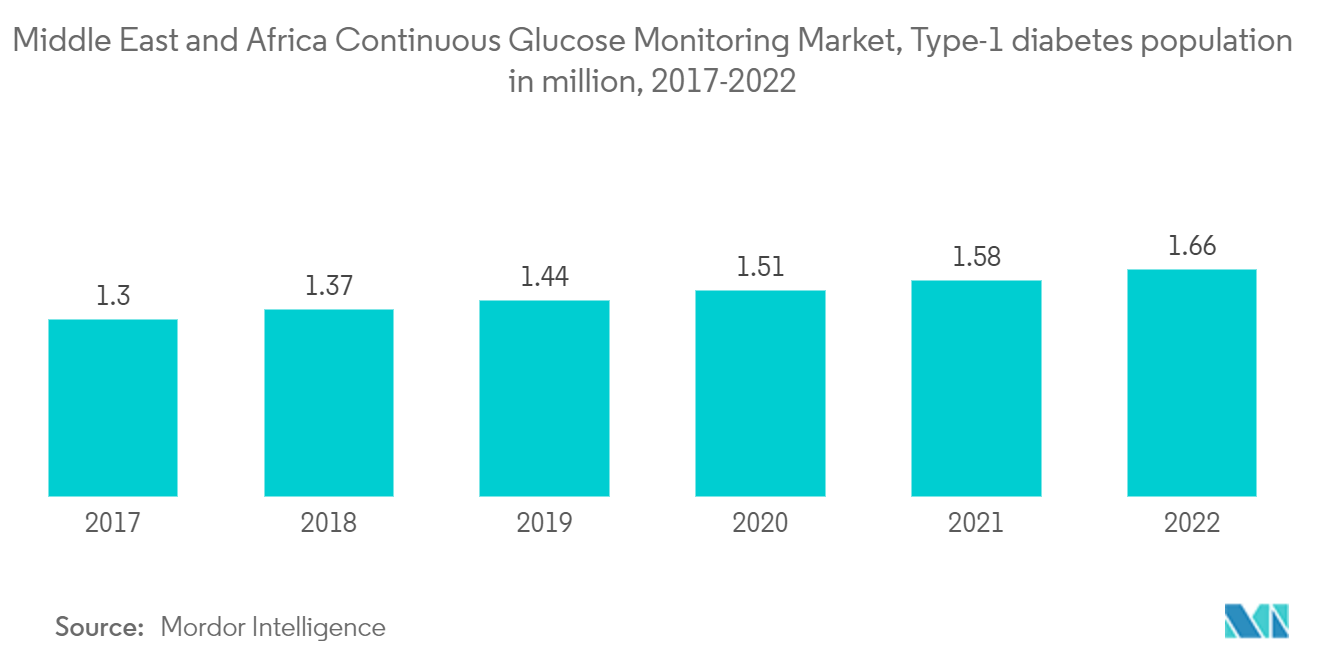Market Trends of Middle East And Africa Continuous Glucose Monitoring Industry
The sensors segment holds the highest market share in the Middle East and African Continuous Glucose Monitoring Market in the current year
Sensors hold the highest market share in the current year and are expected to register a CAGR of about 11.6% over the forecast period.
To use a CGM, a small sensor is inserted into the abdomen or arm with a tiny plastic tube known as a cannula penetrating the top layer of skin. An adhesive patch holds the sensor in place, allowing it to take glucose readings in interstitial fluid throughout the day and night. Generally, the sensors must be replaced every 7 to 14 days. A small, reusable transmitter connected to the sensor allows the system to send real-time readings wirelessly to a monitor device that displays blood glucose data. Some systems come with a dedicated monitor, and some display the information via a smartphone app.
CGM sensors have proven to be effective for patients with frequent hypoglycemic events, sensor-augmented pumps, and gestational diabetes treated with either continuous subcutaneous insulin infusion or a multiple daily injection insulin regimen. Researchers are trying to find and develop alternatives to electrochemical-based glucose sensors and create more affordable, minimally invasive, and user-friendly CGM sensors. Optical measurement is a promising platform for glucose sensing. Some technologies have been reported to have high potential for continuous glucose sensing, including spectroscopy, fluorescence, holographic technology, etc. Eversense, a CGM sensor based on fluorescence sensing developed by Senseonics Company, presents a much longer lifespan in comparison with electrochemical sensors.
73 million adults were living with diabetes in the IDF MENA Region in 2021. This figure is estimated to increase to 95 million by 2030. 48 million adults in the IDF MENA region live with impaired glucose tolerance, which places them at increased risk of developing type-2 diabetes. Governments in the Middle East have identified the threat of diabetes and started to respond with various policies, initiatives, and programs. Six out of 15 countries in this region still do not have a national operational action policy for diabetes. Many countries still do not have a national strategy to reduce overweight, obesity, and physical inactivity, which are important risk factors for diabetes. Most counties have fully implemented national diabetes treatment guidelines. However, constant measures are being taken to minimize diabetic complications; therefore, owing to the aforesaid factors, the growth of the studied market is anticipated in the Middle East and African region.

Saudi Arabia is expected to dominate the Middle East and Africa Continuous Glucose Monitoring Market over the forecast period
Saudi Arabia holds the largest share in the continuous glucose monitoring market in the Middle East and African region and is expected to register a CAGR of about 11.6% over the forecast period.
More than one in ten people in Saudi Arabia were living with diabetes, and the prevalence of the disease was expected to almost double by 2045, according to the report by the IDF 2021. The IDF report 2021 mentioned that 4.27 million people in Saudi Arabia, which has a population of about 34.8 million, had diabetes, while a further 1.86 million people have the disease but are yet to be diagnosed.
It is imperative that CGM devices be used alongside insulin pumps. As the trends show a higher number of diabetic patients using insulin pumps for diabetes management, it can be predicted that the number of units of CGM devices sold will also follow. Type-1 patients require continuous monitoring to keep a close watch on their glucose levels, which is likely to generate demand in the coming years. Due to the adaptability of new technology and the high prevalence of diabetes in the population, Saudi Arabia dominates the market, among other countries.
In July 2022, the Saudi Government announced that Saudi Arabia saw growing demand for quality healthcare services spurred by changes, including an increasing and aging population and a growing prevalence of lifestyle diseases such as diabetes and obesity. The government and private sector are both involved in working on healthcare entities, certifications, and regulations. The government is taking steps to have 100 percent of Saudi citizens covered by insurance and is working towards ensuring affordability, access, and quality digital healthcare and primary care with cost-effectiveness.
Therefore, owing to the aforesaid factors, the growth of the studied market is anticipated in the Middle East and Africa region.


